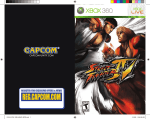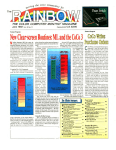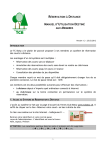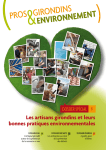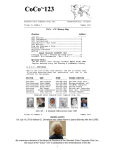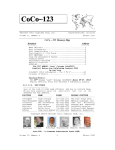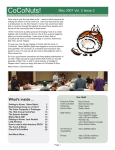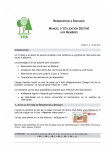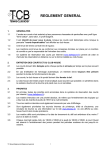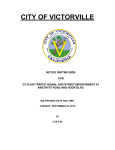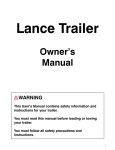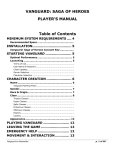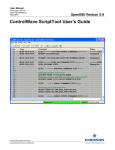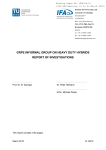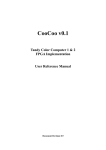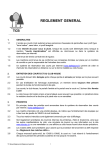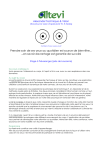Download Volume 33 : Issue 2 - Glenside Color Computer Club
Transcript
savings that we enjoyed. I do not know how that affected the balance sheet of the exhibitors, but I sincerely hope that any savings in the event’s cost was able to boost everyone’s bottom line. CoCo~123 INFORMATION ------------------------------------------------------------------------------------------------------------------------------------------------------------------- CoCo~123 is the newsletter of the Glenside Color Computer Club. Your annual contribution of $15.00 helps to keep our club going. Send your check to Glenside Treasurer: The FEST! is a labor of love, and has not really been an intended moneymaker for the club’s coffers. We have received donated hardware and software, over the years, to include in the No Minimum Bid Auction, and, thanks to the donors, the NMBA has allowed Glenside to meet expenses just about every year. The standing rule has been that “If we do not lose too much money on the fest” (we targeted $300.00, I think), we would make plans for the following year. This year, we actually TRIED to not go into the black, as it was a “give back to the FEST!-goers attitude” (at least with me; the exec. board was trembling) and you would not let us. WE WILL BE RETURNING TO HERON POINT NEXT YEAR! Thank you. (See details at end of newsletter.) George L Schneeweiss 13450 N 2700 E Road Forrest IL 61741-9629 Our treasury provides newsletters and good times with fellow CoCo users at our Annual “Last” Chicago CoCoFEST! and annual Glenside picnic. CoCo~123 CONTRIBUTIONS ------------------------------------------------------------------------------------------------------------------------------------------------------------------- If you have any suggestions for the newsletter or would like to submit an article, please contact the CoCo~123 Newsletter editor: John Mark Mobley 4104 Wren Lane Rolling Meadows IL 60008 [email protected] The Annual Pique-Nique is fast approaching. It will again be held at our treasurer’s homestead in Forrest, IL. Directions are in the recap from last year, later on in the newsletter. IF you can make the trip... and it is a trip... we would love to see you there. Attending the Pique-Nique is like being IN the American Pickers program. (Discovery channel... or is it the History Channel?) It doesn’t matter... you will be fascinated. And the food and fellowship is always good, too. CONTRIBUTORS TO THIS ISSUE ------------------------------------------------------------------------------------------------------------------------------------------------------------------- Neal Blanchard Christopher Hawks Allen Huffman John Mark Mobley Tony Podraza George Schneeweiss Robert Swoger I am excited for the coming events. I hope that you are, too. Till next time, I bid you Peace. G. C. C. C. MEETINGS Tony Podraza, President Glenside Color Computer Club ------------------------------------------------------------------------------------------------------------------------------------------------------------------- The Glenside Color Computer Club meets the second Thursday of each month at the Schaumburg Township District Library at 7:00 pm. If you need a map, see our Glenside Homepage at: TREA$URY NOTE$ ------------------------------------------------------------------------------------------------------------------------------------------------------------------- We have $8228.23 in checking. We have 107 paid members in 2013, down from 136 in 2011, and a total of 414 members to whom we send newsletters. http://glensideccc.com A social get-together always follows the meeting at a nearby restaurant, lovingly called, “The Meeting After”. George Schneeweiss, Trea$urer Glenside Color Computer Club FROM THE PRESIDENT’S PLATEN THE SECRETARY'S NOTEBOOK ------------------------------------------------------------------------------------------------------------------------------------------------------------------------------------- ---------------------------------------------------------------------------------------------------------------------------------------------------------------- Three weeks ago, we targeted 31AUG13 as the drop deadline date for articles for the newsletter. Well, yesterday, 31AUG13, I dropped dead. Oh no, not physically, just mentally and motivationally. I do not know why, but there was no get up and go. So, today, I must make good on the article. It will be in John Mark’s hands tonight. Our 2013 CoCoFEST! went well. We shall do it again next year 2014. Meetings continue to take care of the business of planning the 2014 CoCoFEST! The meeting place will be at the same location as 2013. All of the exhibitors will be located in one room though as many felt they missed half the fest by being in two rooms. We learn by doing. I thought that I could give a brief FEST! report, but after previewing the rest of the newsletter, I see that there is not much that I could add to Allen Huffman’s report. My hat is off to him. He has captured the flavor of the FEST! perfectly. After the last fest it was discovered that our club project, LogiCall, had a bug. Seems that some games presented at the CoCo Coding Contest by Jim Gerrie on drive 44 messed up the LogiCall directory column spacing when LogiCall was called back after the game finished. One line of LogiCall code was modified and the problem was gone. No other bugs in LogiCall have been discovered in the last year and a half since its I can say this, however. Due to the fantastic cost reduction, Glenside was able to pass on to the exhibitors, and to some extent, the attendees, the huge 2 report is being created on an Apple iPad (then later edited in WordPress), so be warned. There may be auto-correct ahead… release. Some programs introduced to us at the coding contest have been added to LogiCall’s virtual hard drive. A Radio Shack CoCo Christmas demo was also found and has been added on drive 52. Be sure to check out John Linville’s Fahrfall on drive 40, Jim Gerrie’s Fest Quest on drive 44, Diego Barizo’s Furious Felines on drive 47 and Luis Antoniosi’s Side Kick is on drive 48. The Radio Shack Christmas demo is on drive 53. BACKGROUND Since many reading this will not know who I am, I decided to add this new section. My name is Allen Huffman, and although I live in Iowa today, I am originally from Texas. I became a CoCo owner in 1982, after starting out with a Commodore VIC-20. In 1990, I started a CoCo software company, Sub-Etha Software, with my friend, Terry Todd. We made our first public appearance at the 1990 Atlanta CoCoFEST!, just before our ads began appearing in The Rainbow magazine. In 1991, I wrote my first CoCoFEST! report (after realizing no one seemed to be doing them any more) and I have continued doing them for most of the events I have attended. In 1995, I took a job with Microware, creator of OS-9, and moved to Iowa. At that time, Sub-Etha was shut down, though I still attended as many CoCoFEST!s as I could. The MOVE function inside DISKS.BAS and TAPES.BAS has been modified to improve its operation. The user can now press <ENTER> at some prompts as a logical answer. To check if you have the latest version of the LogiCall ensemble press <END>, the BREAK key in Vcc. Then type “LIST0”<ENTER>. The version number should be V3.02. Did you know that the install batch file LINSTALL.BAT has a help? Simply type “LINSTALL /?” at the MSDOS prompt to display it. Please simply update your software from our drop-box site to receive all these improvements. Although I am no longer as active within the community as I once was, I still plan to get my CoCo stuff out of storage and set it back up some day, and I still try to contribute where I can — even if it is just “yet another” CoCoFEST! report, or home movie DVD from the event. The LogiCall V7.0 manual was updated. Please download the latest version from: https://dl.dropboxusercontent.com/u/55520144/LogiCall V7.pdf Email me at [email protected] or phone me at 630837-7957 for a FREE copy of the LogiCall Ensemble. A present there are 57 copies of LogiCall have been distributed. Try it, you’ll like it. I have DVDs available from Chicago 2009, 2010 and (soon) 2013, and copies of my “CoCoFEST! Chronicles” book covering 1990-1997 are also still available. And now… My trip report. Robert Swoger, Secretary Glenside Color Computer Club TIMELINE It has been just two weeks since the Boston marathon explosion and the fertilizer explosion in West, Texas. Local gas price is about $3.30/gallon. We have recently learned a new word: Sequester. It apparently means “flight delays.” THE EDITOR’S CLIPBOARD ------------------------------------------------------------------------------------------------------------------------------------------------------------------- Lewis Kornfeld, former president of Radio Shack from 1970-1981 has passed. Lewis was president when the TRS-80 line of computers was introduced. Lewis was the author of To Catch a Mouse Make a Noise Like a Cheese, a book about marketing. THE DRIVE My last trip was to the 2010 event, and for that one I didn’t arrive until after the event closed on Saturday. This year, I had planned to try to head out early on Friday and be there for the Friday evening socializing. Unfortunately, I was broker than broke, and the only way I could justify the trip was by having something to sell to generate income. This year, it would be a new DVD of footage from the 2010 CoCoFEST! I got started a bit too late on them, and had to spend all Friday evening finishing up and burning discs instead of driving to Illinois. For more information on Lewis Kornfeld, search for his name on the Fort Worth Star-Telegram newspaper website: www.star-telegram.com If you have any articles or article ideas, please submit them to me. You can contact me through the club website using the contact us section or the following link: http://www.glensideccc.com/contact/index.shtml John Mark Mobley, Editor 2013 Chicago CoCoFEST! Report At 4am Saturday morning, my alarm went off and I prepared to head out… I did this hitting snooze a few times. Eventually, just before 5 a.m., I was in the car and programming the GPS to take me to the Fairfield Inn and Suites in Lombard, Illinois. This was a new location for the event, so I was trusting that the GPS could get me there. (Anyone remember when we did (April 26-27, Lombard, IL) Recap by Allen C. Huffman ------------------------------------------------------------------------------------------------------------------------------------------------------------------------------------------- NOTE: Any mistakes in this report are most likely unintentional, except for the intentional ones. This 3 this with paper maps?) Initially, the route looked a bit longer than I remembered. It seemed both Apple Maps and Google Maps had suggested a different route than what my car suggested. I soon realized I had disabled “Allow Toll Roads” and thus my car was going to take me 27 miles further to avoid them. (See past CoCoFEST! reports for details on my loathing of toll roads.) state license plates and often seen familiar faces roaming about. Since I wanted to try to get there by opening, and preferred using the route I was more familiar with, I enabled toll roads and recalculated. The new route looked a bit easier. I would be departing from Des Moines, Iowa, and driving on I-80 until Davenport, then heading up I-88 for awhile and then making a short drive up I-355 to the hotel exit. This route took me through several tollbooths, and cost me about $11. I suppose I would have to sell a few extra DVDs to cover that. Sign in the lobby. Camcorder in hand, I went in to the building. It was a large, multi-story office building with a revolving door. The entrance area was large and tall. I noticed immediately a standing sign that read: CoCoFEST! I felt confident it was indeed somewhere in this building. My trip there was uneventful. I only stopped once for gas and some McFood, so I have no fun stories to tell about “sewage lagoons” or visiting “The World’s Largest Truck Stop”. (See past CoCoFEST! reports for details on those.) This time, the most exciting thing I noticed was passing a large factory labeled “NESTLE.” It made me hungry for chocolate, which seemed appropriate heading to a “CoCo” fest. (Apparently I have typed that enough that my iPad is no longer trying to correct the spelling.) A note on the sign said “All conference rooms in the lower level” so I headed to the elevators and took it down to “LL”. THE ARRIVAL Five and a half hours later, I was taking the exit next to the Fairfield Inn and Suites. It was about 10:15, so I knew the Fest had already opened. I drove past the hotel’s main entrance so I could drive around it and try to find where everyone was parking near the conference room. I found myself driving too far and ended up beside a separate multi-story building behind the hotel. I realized my mistake and circled back. After not seeing anything that looked like CoCoFEST! activity outside the hotel, I parked near the main entrance and went in. Sign in the lower level. Notice the QR codes! When the doors opened, I saw clear glass walls in front of me with tables and a cafe type area behind them, and a nice CoCoFEST! sign on an easel. The sign even had a QR code on it, which was the first time I’d see one used in conjunction with the CoCo. I walked inside, camcorder running (to record “virtual CoCoFEST!” footage), and saw a breakfast area in front of me, and two hallways leading to guest rooms. There didn’t seem to be any signage or indication of a CoCoFEST! or even a conference room. The front desk clerk was on the phone, so I walked over to the corridors to see if I could find any signs pointing the way. Nothing. Had I misread the location? I stepped out and looked around. Down to the left was a doorway, and through it I saw Bob “Gator” Swoger sitting at a table behind a laptop. I walked over and peered in to the room. It was tiny. There were only a dozen or so tables along the walls, plus a few rows of tables in the center loaded with random stuff that I assumed was intended for the No Minimum Bid Auction. Very few people where there. I was glad to be back after three years, but had a bad feeling about the tiny size of this event. Had things really dwindled this much in the past two years? The clerk finished his phone call then came out to find me, asking if I needed help finding something. I asked where the conference room was, and he said they were in the next building — the one I initially accidentally drove around. I went back to my car and drove over to park by that building. There was no obvious sign of CoCoFEST! activity, unlike pulling in to previous event locations where you could always identify many out of 4 First look at the CoCoFEST! room. It’s tiny! A look in to the second (larger) CoCoFEST! room. Bob was having problems with the computer, and wasn’t ready to take money and issue name badges yet. I walked around the room and said hello to various folks, and saw where John Strong’s StrongWare table was. Next to it was another table with a banner that said “Sub-Etha Softwear”. It had the original “Software” lettering, with letters “ear” stuck on top of the original “are.” This was from the years after I joined Microware in 1995 and had to stop vending OS-9 products to avoid a conflict of interest and instead sold buttons and Tshirts. I contemplated pulling off the “ear” letters, but in usual fashion, I got distracted and never got around to it. The small room I was in had a door on each end of one wall. I had entered through one door, nearest the elevators, but there was another open door at the other end. I had noticed some CoCo folks coming in through it but just thought they were using it because it was closer to their booth. When I walked over to locate Tony, I saw a small group standing out in the hallway at another door leading in to a SECOND room. Over their shoulders I could see more vendor booths… It seems there were actually two rooms being used for this year’s CoCoFEST! They sat at a 90 degree angle at the corner of the lower level of this conference center. Whew! It wasn’t such a small fest after all! I was a bit surprised to see a table with my former company name on it. I wasn’t even sure until Friday night if I would even be able to attend, since I knew if I didn’t get the DVDs made to sell I would have no way to pay for the trip. John Strong had offered to let me share his table, but since Glenside was only charging $10 for a booth, they set aside a table for me just in case. I love those guys! I found out later that I was originally going to be one table down, but John had Karl Sefcik swap a space so I could be in the middle. I walked in to this other room, and suddenly felt much better. I noticed tables for Cloud-9 and HawkSoft. I saw John Mark Mobley’s large backdrop display. I saw plenty of monitors displaying real (or possibly virtual) green CoCo screens. And, most importantly, I saw folks there I didn’t recognize. New faces at a CoCoFEST!? Each year, it always seems there are a few, so I was relieved to see this pattern continue. As I continued to look around, I was still shocked at how sad and small the event looked compared to when I saw it last in 2010. I was also puzzled that I didn’t see certain familiar faces that I knew were expected to be there, such as Cloud-9 and HawkSoft. Brother Jeremy wasn’t there, either, but I later found out he was now living in England. At the time, though, it just seemed like it truly was going to be the “last” CoCoFEST! I took a few photos and shot a bit of video, then went back out to the car to start bringing in items. In addition to my Fest DVDs, I brought some leftover CoCo buttons I had made over a decade ago and my scrolling LED sign. Five minutes later, I was back in the room, setting things up at the table. John Strong was not here yet, but others confirmed they had seen him. While I was exploring, I heard Brian Schubring (the “Music Man”) fire up his MIDI player to play the anthems that normally indicate the official opening of the Fest. Perhaps Bob Swoger wasn’t the only one having delays? It looked like I hadn’t actually missed the official opening after all! When the music finished, I then heard club president Tony Podraza making a loud announcement. For some reason, he wasn’t making them in the CoCoFEST! room. That’s weird. I wondered where he was and who he was speaking to. I began the task of trying to remember how to program my old BETA-BRITE LED sign. I had not really used it since around 2000 at the last PennFest, and I hoped the remote control batteries would still work. It was quite a struggle to remember how to enter in the color and scroll sequences, but I managed to at least get a few simple messages going. While I was fussing with it, John Strong made his appearance. It was good to see him again. 5 First Room (C): +--------------------------------------------------------------------+ | Glenside David Bargeman Sub-Etha StrongWare | | IDE Keil Research Software | | Dan | | Keller | | | | G | | C O'Keefe | | C Mike John-Mark LogiCall Music Man | | C Rowen Mobley | +--------| |-----------------------------------------| |---------+ Second Room (A & B, combined): +--------------------------------------------------------------------+ | CoCoBoot Pitre Cloud-9 Drivewire Crislip HAWKSoft GriffArt | | Tech CC Coding | | Nosko’s | | Chasteen Laser | | | | Frank John | | Pittel Linville | | Lost Andrew Mark | | Wizard Weiler Martin | +--------| |-----------------------------------------| |---------+ Sub-Etha Software table. Andrew Weiler – Andy had a booth to both support the festival and to have a place of his own to sit & chat and store any purchases he might have collected. He is relatively new to CoCo and is still working to build his system. StrongWare had two new CDs to sell, each with various John Strong games on them including a brand new one. I worked on putting in descriptions and prices in the LED sign while he unloaded. He left to get more, and soon returned with a huge ink jet printer which he would be using to print out the CoCoFEST! group photos he started doing back in 2009. Bargeman Research Labs – Karl Sefcik was once again there with a booth to help support the festival. His table always has a bizarre grouping of seemingly random items. He donated a T1 phone system of some kind to the auction this year, for example. One of the key things Karl did during the show was monitor the CoCo IRC chat room and let us know when folks were having issues with the live video stream. Towards the end of the event, he would also help the club sell a few more souvenir writing pens by taking orders and getting the pens from Glenside. Very useful, Karl! Although our tables were pretty bare, I at least had a whole set of old CoCo buttons on the table, and a small stack of DVDs. I used my old MacBook to start playing the DVD, and then decided it was time to walk around a bit and see what this year’s event had to offer. And maybe find a restroom. THE SHOW AREA 2013 Chicago: The festival occupied all three conference rooms (A, B and C) of the Heron Point Conference Center and made use of the cafe area for seminars. The smaller entrance room was Heron Point C (1760 square feet), and the larger room was made up of the A and B rooms without the dividing wall between them (2160 square feet). The claimed maximum capacity (when configured in a theater layout with just seating) is 190 people, so there should be plenty of room to grow in this location. You can visit http://www.marriott.com/hotels/eventplanning/floor-plans/chifs-fairfield-inn-and-suiteschicago-lombard to see the hotel’s actual floor plan of the rooms that were used. Cloud-9 booth. No show guide was provided, but I was able to obtain the hand drawn layout map from Linda Podraza. This may very well be the most accurate fest map I have ever included. Except for the items that were changed after the map was drawn. Cloud-9 – (video interview) Mark Marlette was showing off their new TRIAD 512K memory upgrade for the CoCo 3. It was a tiny blue circuit board with only three small chips on it. It used SRAM and they claim it has a 90% heat reduction over old style memory upgrades. It also uses only 1/20th of the power, which means a CoCo 3 using it should run cooler and use less power 6 than even a stock 128K model. Mark referred to it as “the CoCo finally goes green.” At $50, it seemed quite reasonable and I expect to upgrade my CoCo 3 as soon as I get it set up again. Little things like this might just let us get a few more years out of the old hardware. Strangely enough, I found the semigraphics game to be very compelling in spite of the limited display. It seems the past few years of “casual gaming” have brought out much interest in simple games (wrapped in fancy high tech graphics) that they may actually have more appeal now than they would have thirty years ago. Certainly, Pitman was every bit as enjoyable as any modern “casual” game. I look forward to exploring the www.cococoding.com website to see what the other entries were. (Check out that site, and follow the links. One entrant, Jim Gerrie, has created dozens of recreations of classic games for the CoCo and MC-10. Ever see Joust on a VGD screen? Neat!) Full details on the winning entries can be found in the Seminars section of this report. Mark also had various development boards on the table that were variations of things like Arduinos. He showed ones that was being used to develop a new SD card interface, and one that had USB support. All of these projects are for components of the long-awaited SuperBoard upgrade. For those who weren’t following this over a decade ago when the idea first came up, the SuperBoard is an “everything” upgrade that would plug in to the CoCo 3 where the memory upgrade and 6809 go. The 6809 would have to be replaced with a socket to do this, but beyond that it would be a plug-and-go upgrade. CoCo LogiCall V7.0 Operating System Ensemble – For years, I have been aware of a product called LogiCall that Bob Swoger created for Timex/Sinclair computers. Recently, with the assistance of John Mark Mobley and Chris Hawks, he brought out a Color Computer 3 version of the ensemble. Even though it was first shown at the 2012 CoCoFEST! this was the first time I actually learned all the things that it did. SuperBoard has evolved considerably since the original design, and when it is released, it should bring us hard drive replacements, USB support, networking and other much desired options. Various products that Cloud-9 has sold over the past years were created to test concepts destined for the SuperBoard. As one who place a down payment on the SuperBoard years ago, I look forward to it finally shipping. Other items of interest on the table included an updated PC keyboard adapter, and some miscellaneous used items for sale including a Telepak II. I remember seeing this RS232 pak replacement being advertised in The Rainbow magazine, but I do not know if I ever saw one in person until this event. CoCoBoot Project – No information available. Bob & Rea. - Reagan asks Grandpa to call in the “Winnie the Pooh in the Hundred Acre Wood” game on Disk 43 that Rich Bair repaired for her at the CoCo Picnic last year. She plays it often. CoCo normally comes up with a green screen and little else when you first power it on. With LogiCall on your CoCo, you power up the CoCo and a very easy to read Blue Screen appears with a catalog (directory) of all the BASIC programs on the current disk. If you want to see all the programs on that disk, press <V><ENTER> and all the programs will be displayed. Press <ENTER> 3 times and a file card system is called, DISKS.BAS, which contains 40 boxes each with 20 slots that shows you where your programs are located on your virtual hard drive of 256 individual disks. That is enough space for 400 programs with notes, very important now as Vcc and DriveWire both can store 256 disks of programs. CoCo Coding booth. Furious Felines on the left, and Pitman on the right. The 2013 CoCo Coding Contest – Aaron Wolfe (“the DriveWire guy”) was hosting the 2013 Color Computer Coding Contest. At his table, you could see various entries running and try them out. I checked out Furious Felines for the CoCo 3, and some semigraphics game called Pitman. They really brought back some memories to the early days of 8-bit computing. LogiCall allows you to go to any disk by simply typing in the disk number and allows you to launch a program by typing in its name. If you don’t want to type in the file name, pressing <ENTER> once will allow you to 7 Glenside MARK II IDE Interface – (video interview) Brian Goers was the man in charge of arranging the seminars this year, as well as staffing the IDE project booth. Through the years, Glenside has created a few hardware projects, including a short run of MIDI interfaces. This IDE project was an early effort to bring IDE hard drives to the CoCo. They still have about 70 of the boards left, and were selling them off for less than $10 each since today IDE is pretty much obsolete (but you can still use the IDE interface and go to memory cards). highlight the program using the arrow keys. Press <ENTER> and the highlighted program runs. LogiCall provides 22 single keystroke entries to start ALL CoCo’s disk management functions. You don’t need the manual on hand to remember all that LogiCall can do for you, though a well-written manual is provided. Just press F1 and a two-screen help file is presented. Pressing <T><ENTER> calls the Terminal program and pressing <W><ENTER> calls the Word Processor. Press <A><ENTER> to write AUTOEXEC.BAS to the current disk making that disk bootable. Pressing <N><ENTER> will boot a bootable disk. Typing “DOS” after calling drive 255 boots OS-9. When the Glenside IDE Interface was first introduced it didn’t work right out of the box and folks complained about this. They had to purchase software from yet another vendor to make it work. The manual was not written well enough for purchasers of the interface to get it going with ease. LogiCall displays text documents and pictures to the screen without first launching an application. LogiCall improves the ease and operation speed of the CoCo, keeps calluses off your fingertips and holds down carpel tunnel. The Glenside MARK II IDE Interface fixed this problem. Chris Hawks wrote software to complete the system and Brian Goers improved the manual. Owners of the original IDE Interface may contact Brian at [email protected] and receive a copy of the new MARK II Disk and new manual for FREE. You can have a copy of the LogiCall V7.0 Manual by downloading it from https://dl.dropboxusercontent.com /u/55520144/LogiCallV7.pdf Dan Keller – (video interview) Dan is a fan of vintage computer (he was wearing a Commodore 64 shirt and an Atari 2600 hat) as well as a professional cartoonist. For the show, he created an original piece of artwork which was a Tandy/Radio Shack themed “My Little Ponies: Friendship is Magic” character. (See Auction for more details.) He had a variety of different prints and original pieces of art, including a really nice TRON Legacy inspired piece which would have come home with me had I any money to spend at this event. To learn more about his artwork, visit: http://www.projectdestinystudios.com. Dave Keil’s CoCo Emulators – David Keil has a wellknown TRS-80 Computer Emulator page on the Internet. He has created emulators for the TRS-80 Model 1, Model III/4, and CoCo 1/2/3. His CoCo emulator was one of the first ones available, though it hasn’t had much development since 2001. David returned to the CoCoFEST! This year to give a seminar about how you can use the free VirtualBox software to run old DOS style apps, like his emulator, on modern Windows systems. He also had a variety of used CoCo items to sell, including a CoCo 3, Orchestra-90 paks, Speech paks and CoCo service manuals. At his table, he had both the original green CoCo 1 service manual, and an updated version that was in the white book binding like the later CoCo 2 and 3 manuals were. I had never seen one like that before and had no idea Radio Shack updated the format. I took a number of items off his hands, via proxy sales to folks unable to attend the show in person. Glenside’s IDE project booth. The IDE board is huge. It was designed with a few unique features that go beyond just being a hard drive interface. Brian showed me where they had two places on the board to solder in CoCo edge connectors and use it as a Y-cable. You could plug in the interface, as well as a floppy controller and RS232 pak, for example. There were also a few spots where you could add extra components if you wanted to wire up a realtime clock or other hardware. Someone at the Fest suggested I take a look at them, since it was a cheap way to get a CoCo prototype board to experiment with, even if there was no need or desire to use it as an IDE hard drive interface. These boards have quite a bit of history behind them. In 2009 I interviewed Jim Hathaway who showed one of the first prototypes. Over the years, various folks were involved with revising the hardware and software. It would be nice someday to read a full write up of the Frank Pittel – Frank had a complete CoCo system, which could be used to test and evaluate software and hardware found at the show. His table provided a donation to the club. 8 history of the project and learn who all did what. Today it seems we just see it as “that booth in the corner at the CoCoFEST!” Perhaps someone will read about it in this report and find a new use for those boards. I am sure they’d love to sell you a few. This year, he was showing off one of the most unique PC keyboards ever made. Chris has taken a CoCo 3 case, and removed the internals. Inside was a small microcontroller (a Teensy 2.0 from prjc.com). It was connected to the keyboard connector, and he wrote code to translate the keyboard matrix in to USB keyboard commands. This keyboard could then be plugged in to a PC, Mac or Linux machine for those who wanted to have a “real” CoCo keyboard when using an emulator. At the show, Chris had it plugged up to a tiny Raspberry Pi computer ($25-$35) and he demonstrated booting up to a Linux shell prompt, then typing (on the CoCo keyboard) commands to load and run the M.E.S.S. emulator. In a moment, he had a full virtual CoCo 3 running The Sands of Egypt. If you had just walked by, you would have no idea that the CoCo 3 he was typing on wasn’t really a CoCo. Glenside Color Computer Club – The host club for the event, Glenside, always has a table at the entrance for selling fest admissions and issuing name badges. This year, they ran out of the plastic badge inserts and only had some leftover smaller ones. We all took different approaches as trying to affix our larger badges to them, such as folding or trimming them down. Amusingly, to me, where the cartridge port for the CoCo was, Chris has mounted a small USB hub. Just like many modern USB keyboards, this USB CoCo keyboard also had a built in hub. Chris said his next goal was to mount the tiny Raspberry Pi inside the case so you could have a self-contained Virtual CoCo. It was really neat. Years ago, there was a CoCo 4 project that intended to do something like this, but at the time, the costs would have been much higher. The Raspberry Pi really does change things. Chris has plans to make his work freely available for those who wish to recreate it, but it didn’t sound like he was going to make it a product. His wife, Nancy, also had a pretty display set up with some of her creations. I did not get to speak with her much this year, so I will describe what she had in an uneducated way: something that looked like it was patterns sewn on cloth that probably took a ton of time to do. Griff-Art – Linda Podraza, Tony’s wife, often sets up a table with various craft/art projects she has been working on. She did not set up her table this year, though. HAWKSoft – Chris and Nancy Hawks have been vending since the days of Rainbowfests. Chris was still there with his doctor’s robe full of past fest name badges and, like usual, he had something new to demonstrate. In past years, he has shown off things like a CoCo 3 SVHS adapter, that allowed you to hook a CoCo to a modern TV and get much higher quality than using the composite outputs. He can stop buying floppy drives any time he wants. Jim O’Keefe (aka, “Jose Jiminez”) – (video interview) Jim claims to have an addiction to floppy drives and controllers, so he rented a table to hold his collection. Chris Hawks of HAWKSoft and his virtual CoCo 3 running on Raspberry Pi. 9 He was seen with a stack of about eight floppy drives piled on his table. He had brought various bits of his gear to test the equipment out. He originally got in to the CoCo around 1982, and had attended the first three or four Chicago Rainbowfests. By the time the CoCo 3 came out, he had moved on to the PC but, a few years ago, some Internet searches made him nostalgic and he started getting back in to the CoCo. His next demo was Follow Me, a Simon style game. I believe he said he wrote it as a way to use a special paddle type controller he built. He referred to it as a rotary controller, so I assume it was a spinner that rotated 360 degrees instead of a traditional paddle that would stop at each end. It looked like the standard black CoCo joystick base (with the single red button), but there was a spinner controller where the joystick would have been. The game was entered in the RetroChallenge game this past winter, and it was shown playing on a Tano Dragon CoCo clone. He shared an amusing story about how he crashed the vendor party after the original Rainbowfest, and then mentioned how he and a friend (Chuck Yeager, but not the test pilot one) had a CoCo software called Zytech Limited. They wrote an adventure game called Plateau of the Past, which was a graphical adventure that did not require a bunch of typing. Jim had a great sense of humor and was great fun to chat with. I hope to see him at a festival again. Third was his game Fahrfall (alpha test 3). This was an experiment in using the colorful semi-graphics modes on the CoCo 1/2 machines (64×96 with 9 colors). The game would not run on a CoCo 3 due to it lacking those modes. This game involved a human player that could be moved left and right, and the goal was to run off the end of platforms that slowly moved up the screen, and to land on a platform below. If you missed, the player fell off the screen. If you didn’t jump soon enough, the player would be crushed by the top of the screen. It played really well and the animation looked great considering the low resolution graphics it used. He had it playing on a custom joystick that had a nice arcade button, and a good feeling digital arcade joystick. This game was winner of the RetroChallenge Winter Warmup 2012. John Linville – (video interview) John has been contributing some interesting projects lately. This year, he had four different projects lined up on his table. The first was the CoCo 3 video player which he originally demonstrated in 2010. The player displays 2, 4, 16 or 256 colors, and works in any CoCo 3 resolution. He had a video loop demonstrating these difference modes. For some reason, the 4-color mode really reminded me of Commodore 64 graphics. The 256-color mode works only on a composite monitor and uses various tricks to simulate that many colors. He would convert standard videos over to a specialized format, then they would be loaded on a CoCo format compact flash card in the Cloud-9 SuperIDE interface. His player would boot up via HDB-DOS, then play as much video and sound as could fit on the card. He previously showed off complete movies being played on the CoCo. The quality, of course, is very low compared to modern technology, but to me it reminded me of what all web video looked like back around 1995. A very impressive feat for an 8-bit processor designed in the 1970s running on a computer from 1986! His fourth demonstration was a new game called Sluzzle. It was a sliding picture puzzle game where a graphic was divided up in to blocks and you moved them around to put the picture back together. The unique aspect of this was that it used some tricks on a CoCo 1/2 to simulate 44 different colors. By changing video modes and flickering between screens, he could get very colorful photos that looked pretty good from a few feet away. It was easily the most impressive photo displayer I have ever seen on a CoCo 1/2, and being able to use this technique in a simple game was a nice bonus. When asked what his next project was, he mentioned doing more work on the 44-color viewer to see if he could get even more colors out of it, including pure black and pure white which his current version does not do. He also mentioned that he acquired Steve Noskowitz’s laser show equipment (see Seminars), so he may be working on that for the next CoCoFEST! To learn more about his projects, visit http://vdgtricks.blogspot.com. John & Marge Chasteen – John supports the club by having a booth and setting up his CoCo gear. He also sells fest buttons, past and present. It’s a great way to get help on anything CoCo-related. John Mark Mobley – This year, John Mark Mobley was showing off a Raspberry Pi. His colorful tabletop display still had some CoCo screen shots and information, but some of the sections were now changed out to describe the Raspberry Pi educational computer. This $25-$35 Some of John Linville’s demos. 10 computer was a full ARM processor Linux machine, capable of running as a “headless” Unix style system (that you could telnet in to over a network), or you could hook it up to a TV set using composite video or HDMI. It had a USB port that could be used to hook up a mouse and keyboard, and then you could run a full GUI and use it like a desktop computer. chance to get a “CoCo 4″ but it wasn’t the product or price we were willing (or able) to support financially. Perhaps another attempt will be made at some point as this form of emulation was quite impressive. Also found running at his booth was a copy of Dungeons of Daggorath. I forgot to ask him why, but perhaps this was a reference to his “Lost Wizard” name…? Mark Martin – Mark has an Arduino project here was working on at the Fest. He used the time to do some soldering, and to make contact with other CoCoists to exchange ideas. Mark is working on one of several “hook an Arduino to a CoCo” projects right now, but his is a bit different. He seems to be shooting for a retro Cloud interface, which would let the CoCo (then, other retro computers) use cloud storage as a virtual file system. This is an interesting spin, and similar to some of the network mounting options that Roger Taylors SD pak product had and some of the capabilities in DriveWire. It really is nice to see so many potential options coming out, rather than just having one that we have to “take it or leave it”. On e-Bay, this might be hundreds of dollars’ worth of gear. At the Fest, cheap! John Mark Mobley and George Schneeweiss (Glenside Treasurer) check out the Raspberry Pi. Although still not quite an off-the-shelf home computer like the CoCo was, it took very little extra hardware (cables, case, power supply) to turn it in to something that is much closer to a cheap home computer you could hook up to a TV and start using. Instead of disk drives, it uses an SD memory card. And, not only does it run tons of Linux software, it can run a CoCo emulator as well, or act as a Drivewire 4 server to a real CoCo. It’s truly an amazing achievement for such a low price. And though I am normally puzzled by the appearance of non-CoCo hardware at a CoCoFEST!, the ability to have a Pi run a CoCo emulator does seem to make it qualify as something on topic. Lost Wizard Enterprises – (video interview) William Astle (from Canada, eh?) had an FPGA board running Gary Becker’s virtual CoCo 3. William was showing off a Freecell game he wrote to enter in to the CoCo Coding Contest (spoiler alert: it won in the <16K category). He explained that the FPGA could run at speeds equivalent to a 25MHz 6809, but it wasn’t 100% timing accurate so certain things, like SockMaster demos, did not run properly. For all other items that didn’t require such cycle accurate timing, it ran just fine. It was hooked up to a VGA monitor and PC keyboard, and I believe it was emulating a standard Tandy floppy controller, and using an SD memory card for storage. Very neat. Mike Rowen – (video interview) Mike started out on a TRS-80 Model I, then moved on to a Color Computer 2 and 3 later. He was a Unix professional, so he worked with OS-9 and UUCP. Around the mid-90s, he left behind his CoCo hobby, but returned about three years ago after buying a replacement on e-Bay. At this show, he had some neat “Long live the CoCo” coffee mugs which had a screen shot of NitrOS-9 on one side and Disk Extended Color BASIC on the other, as well as a CoCo 1, CoCo 2 and CoCo 3. He promoted them as “CoCo 1, 2 and 3 compatible.” He also had a table of $5 ROM Paks, including Dino Wars. He also had some free stickers to give out, including one that said “TANDY Color Computer 8-bit POWER”. The hardware was a reference platform from the company that sold the FPGA chip. This was going to be the basis of the CoCo-X project Gary Becker had recently tried to get funded via Kickstarter, but it feel short of the $50,000 goal he wanted. It seems we had a The Music Man – (video interview) Brian Schubring once again was on hand to provide some background music and, if needed, amplification. Brian’s CoCo MIDI setup was booting via Drivewire, then running off of a 11 small 2.5″ laptop IDE hard drive. It was quite the downsize from a huge PC tower case repack he used to use. interfacing with the CoCo memory map. He then soldered on a header connector which could plug in to a row of I/O pins on the Arduino. Nosko’s Laser Show – Passing the Baton. Along the back wall of the room was a dancing laser beam projected on the wall. What an unusual thing to see at a CoCoFEST! Steven Nosko is now a retired Motorola employee who, at one point, built a laser show display that was controlled by an original grey case Color Computer 1. He actually visited a CoCoFEST! once before to present his show and discuss it, and it was good to meet him again. This year Steve took the opportunity to meet John Linville and pass the baton. John Linville shall become the new CoCo laser man. John received all the required hardware, software and docs needed to continue throughout time while Steve kept just enough to help John learn the system. See the Seminar section for a full description of Steve’s last seminar. He created special software to run on the Arduino, and then modified HDB-DOS on the CoCo to talk to it. His results were very high speed Drivewire transfers to a microSD card on the Arduino. There have already been ways to use a memory card as a hard drive, such as the Cloud-9 IDE board and the SD Pak sold by Roger Taylor, but these approaches require the card to be formatted for the CoCo or OS-9. Boisy’s approach used a standard FAT formatted memory card, and interfaced between disk image files on that card. This meant you could take the microSD card out of his interface and read it in a computer or copy over new disk images. Anyone who has ever tried to mount an OS-9 formatted Compact Flash card under Windows will know how well that doesn’t work. It was also quite fast. He was able to achieve “megaread” speeds much closer to that of hard drives, while the bitbanger serial port approach creates speeds similar to floppy drives. By using memory mapped I/O, he was able to read and write a byte of data instead of having to send out a stream of bits one at a time. This was easily one of the most exciting projects I have seen at a CoCoFEST! in years because of the potential to support other things. Boisy pointed out that the Ethernet port on the Arduino he was using could be used as well, and code could be written to allow this interface to act as a hard drive, internet gateway, virtual serial port or just about anything else that could be plugged up. By making it work over the Drivewire protocol, only one base device driver would be needed. Instead of requesting a disk sector, it could read or write serial data to a com port or internet socket. Current Drivewire already offer this, but it requires having a full computer booted and physically connected to the CoCo. A micro server like Boisy was working on could be designed to live in a ROM pak case, and free the CoCo from any dependencies on another machine. This was an exciting idea. Even with small Linux servers like the Raspberry Pi being available, they still have the complexity of a full operating system to maintain and update and are certainly not “plug and go” like a custom designed interface could be. Pitre Tech. Look for his CoCo history book coming out later this year! Pitre Technology – (video interview) Boisy Pitre had his own table next to Cloud-9 where he was showing off some of his experiments. Before mentioning them, it should be noted that he is also working on what will be the definitive book on the Color Computer. It will be called “CoCo: The Colorful History of Tandy’s Underdog Computer” and is written by Boisy G. Pitre and Bill Loguidice. They expect it to be released before the end of 2013. As far as projects, Boisy had initially attempted to use an Arduino as a micro Drivewire disk server, but he found that the timing of the Arduino was not stable enough at the high speed baud rates needed, so he looked for a different solution. He was showing off an Arduino interfaced to the CoCo cartridge port. Years ago, Boisy had purchased some old parallel port interface boards from Dennis Kistz. (Dennis is the gracious host of the MaltedMedia CoCo mailing list, and former operator of Green Mountain Micro back in the early days of the CoCo.) Boisy decided to populate these bare boards with the chips necessary to allow If you want to learn more about this, Boisy has documented his experiments online. See http://arduinococo.blogspot.com for more details. One other item Boisy was showing was a “CoCo SDC”, a special FD502 disk drive controller pak that contained a custom circuit board which emulated the original Western Digital FD1773 chip. This project was by Darren Atkinson, and his goal was to create something that looked just like a standard floppy controller to the CoCo, but used SD cards for storage instead of a physical floppy drive. 12 allowing virtual disks to be swapped out on demand and appear as DRIVE 0 for full compatibility. It’s certainly a fascinating project, and I hope it comes out as something I can buy. With all these options – SuperIDE memory cards, Drivewire to a PC or micro server, emulated floppy controllers – we have some wonderful choices. Richard & Brenda Crislip – Had a complete DriveWire & CoCo setup. He demoed the capabilities of DriveWire. Having a booth was a means of socialization and getting to know club members better. Roy R Justus – Roy was scheduled to attend, but did not make it. I was disappointed in this, since in the past, I have seen recreated “program by switch” computers, walking hexapod robots and various other creations of his. He’s also the guy who created and sold a CoCo 3 to VGA adapter, so his contributions to the show were missed. Darren Atkinson’s CoCo SDC prototype, and Boisy’s CoCo Arduino experiment. The circuit board inside looked very professional, and enough work had been completed to allow it to be demonstrated. Boisy had a printout of instructions, and although the CoCo powered up with the standard “DISK EXTENDED COLOR BASIC” copyright notice, he quickly showed us that it was not the same DISK BASIC. There was a minor extension that had been added that let the user specify which disk image on the SD card could be loaded as a virtual floppy. Boisy typed something like: StrongWare – (video interview) John Strong was offering two CDs of his game products. One disc was the StrongWare Collection, and it featured his Tetris clone, Soviet Bloc, as well as his Columns clone, Gems. There was also a Simon Says type game on it. The disc was sold for $20, I think, and it contained emulator-ready files. Soviet Bloc and Gems were possibly the only CoCo games ever made that supported stereo sound via an Orchestra-90 pak. DRIVE 0,”DK.DSK” This told the virtual drive controller to map in an emulator disk image called “DK.DSK” as drive 0. Then, typing “DIR” (or “DIR 0″) would show the contents of that disk image as if it were reading sectors from a physical floppy disk, Except much faster! Since there was no waiting on floppy disks to spin up and seek, access time was noticeably faster than a real floppy. The CoCo ROM disk code was completely unaware that it was not talking to a real floppy drive. This would, by theory, allow programs that used their own custom disk routines to work, while they cannot work in an RGB-DOS or Drivewire environment. John Strong shows off his new game Gems 2 running in a CoCo emulator. Some examples of this include games like Marty’s Nightmare and Z’89 by Steve Bjork. One of these games used 512-byte sectors, and the other 1024-byte sectors. These nonstandard sector sizes, as well as missing track 0 and other tricks, acted as copy protection and prevented them from running from hard drive systems. Darren’s interface supported a .DMK format which could replicate these nonstandard disk images, allowing copy protected software to run from SD. (In an e-mail, Darren explained that Carl England’s Defeater program was used to clone the protected disks in to disk images that contained the same track and sector format.) His second CD contained his new game, Gems 2. Gems 2 was a different type of puzzle game, where the screen was full of colored gems and you had to click on a certain color to make all the connected gems of the same color disappear. (Bubble Bobble?) John explained that the game allowed a replay of the level using the same pattern so you could try again to beat it. It also had an undo and redo feature, so you could take back moves in case you got stuck. John also showed off some of his Windows-based development tools he has been creating. He had a tile editor, for games, as well as a sprite editor. He also had a disk utility that could do the typical things like move files in and out of an emulator disk image, but also view and edit some of those files. He could directly view VEF graphics files as well as some of the RS-DOS formats. Another problem usually encountered when moving RSDOS software to a hard drive is that many will only run from Drive 0 (or Drive 0-3, without being patched). This virtual drive controller gets around all of these issues, 13 His work-in-progress program even allowed editing the disk images with a hex editor, or manipulating graphics files (like a Paint program). He also secretly showed a huge level map for an unannounced game project he has been working on. If he can sell some copies of Gems 2, he says he will continue development on the new product. If there is no interest or support, he may be done developing CoCo items. being used by the fest, but a central cafe area with chairs and tables (and water and coffee). The cafe area was being used for seminars this year, but since it was just a few steps away from the doors of the fest rooms, and since it had glass walls, I suppose the merchants didn’t feel quite as lonely during the seminars. Saturday: 12:15 – “CoCo Laser Show” – Steven Noskowitz Sub-Etha Software – At my table, I was selling two CoCoFEST! DVDs. One was a compilation of interviews and footage from the 2009 Chicago CoCoFEST!. This disc included interviews with various vendors and some attendees, including the late Howard Luckey, as well as footage from the No Minimum Bid auction and Saturday Night Music Jam. The disc served as a companion to my 2009 trip report, which was included on the disc along with all the digital photos I took that year. Since I had previously sold this disc at the 2010 show, I had only brought four copies to sell, and I sold them all. I also had a brand new 2010 DVD which had much more footage on it, but no room for any bonus content like photos. This disc featured 19 interviews, and a CoCo demo seminar by John Mark Mobley. It also had Tony Podraza speaking about the passing of Howard Luckey. (The 2010 event was dedicated to his memory, and his photo had appeared on the name badges that year.) Sadly, that was not the only tribute on this DVD. Malcolm Cleveland had also passed away, so I included an interview with him as well as a short extra clip “In memory of Malcolm Cleveland.” He was always a pleasure to talk to, and will be missed. I really hope my 2013 DVD doesn’t have another tribute to another CoCo family member we lose. In 2002, Steve showed up at a CoCoFEST! and gave a talk on his CoCo 1 based laser show. He was back again and demonstrated the original show, as well as some other things he had created over the years. He showed us star constellations (done for a Boy Scout troop, I think he said?), some space shuttle landing animations, and a spinning Motorola logo, among other things. He spent some time demonstrating how the laser worked to create the shapes we saw on the screen. He would change speed settings to show how some dots could appear as a line, or a square, or, if going too fast, a square with rounded corners. It was fascinating to see how new this “old” equipment worked. It still seemed quite impressive, decades after he designed and built it. The last item I had was a new printing of my CoCoFEST! Chronicles book, which contains versions of my trip reports from 1990-1997. The book was made available in 1998 in a spiral bound format, and I was showing off a new paperback edition that had the same type of binding that a normal book had. Technology has made it possible to print something like this at a lower cost, so if there is interest, I will create a new edition to offer. Steve Noskowitz explains how he built his CoCo 1 based laser show. This was one of my all-time favorite presentations. One change I noticed from his original presentation was that he was now playing audio from a PC laptop instead of a cassette tape drive. 1:15 – “LogiCall” – Bob Swoger THE SEMINARS Early festivals I attended had separate seminar rooms for the presentations. As attendance numbers dropped, during a seminar the festival room would empty out leaving the merchants all alone and lonely. Glenside decided to save some money on the seminar room rental (which also helped compensate for the drop in income from fewer tickets sold) and have the seminars in the actual fest room. Over the years, various approaches were taken, such as having an area near the center of the room be set aside with seating, or just having folks move chairs from one place to the other when a merchant gave a talk. Bob Swoger demonstrates the LogiCall Ensemble. This year, things reverted back to how they used to be. The conference center not only had the two rooms 14 properly on a modern 64-bit Windows system. VirtualBox can be used to run older applications inside a virtual machine on a modern PC. Bob gave a walk-thru demonstration of his LogiCall disk operating system environment for the CoCo 3. This program originally started out on a Sinclair computer, but has been ported over in recent years. Read more about it in the CoCo Coding Contest section. 12:30 – “CoCo Coding Contest” – Aaron Wolfe Earlier this year, a Color Computer programming contest was announced. A website, www.cococoding.com, kept track of entries. There were 18 entries in various categories, and you could see them run at Aaron’s booth. Aaron set up two flat screen monitors displaying a slide presentation as he described each winning entry. I would liked to have seen a demo of each program so I could understand more about it, but I suppose that is what his booth was for with the demos running. 2:00 – “No Minimum Bid Auction” – Tony Podraza The annual tradition of “selling all kinds of good stuff and junk to help Glenside pay for the Fest” was held once again. This year, there seemed to be much more “good stuff” than “junk” with things like CoCo 3s and 2 meg memory boards coming up for auction. Tony was also in great form this year and zipping around enough to make me feel tired watching him. 5:00 – “Group Photo” – John Strong While not a seminar, this was a loosely scheduled event so I will mention it here. John Strong gathered everyone together outside in front of the conference center for a group photo. The outdoor location was chosen, I assume, to avoid having to set up all the umbrella lights this year. Using a timer, John was able to be in the picture too. I was in the one he did in 2009, but I showed up too late in 2010 to be in that one. I do not know if he has taken similar group photos at the shows I missed (2011 and 2012). The winners were announced (and live streamed on the internet) during this seminar. Aaron Wolfe’s CoCo Coding Contest winner announcement. Best Puzzle Game – Pipe Frenzy by Jim and Charlie Gerrie. This game required the player to lay down pipe pieces so the water could flow without spilling. My understanding is that this is a father and son team. They have cranked out dozens of games (including a Doctor Who one!) with many being compatible with the MC-10. The games make use of the original CoCo (and MC-10) semi-graphics displays but, while primitive to look at, they have some excellent game play. John Strong’s CoCo Family Portrait. If you were at the festival and would like to get a print of this photo, contact John Strong. A huge print of this photo was then offered on Sunday in the No Minimum Bid Auction. John tried to get as many of us as possible to autograph it around our picture. Sadly, I think this huge print only went for $10. I was really surprised it wasn’t bid up higher to help the club out. Audio Category Winner – Sound Chaser by Bill Piece. This OS-9 program is designed to be the “one player to rule them all” for the CoCo. Most Talked About Program – LogiCall by Bob Swoger, Chris Hawks and John Mark Mobley. Aaron explained the LogiCall is not just one program but is instead an ensemble of many utilities that allow LogiCall to do everything for you on your CoCo Disk System. For more details on LogiCall, see the Show Area write-up. Sunday: 11:00 – “Emulator on VirtualBox” – David Keil I was not present during this seminar, but it was meant to be a discussion of using the free open-source VirtualBox emulator to run older programs on a modern Windows computer. David Keil wrote one of the early Color Computer emulators, but I gather it does not run Best BASIC Game – Scrabble Helper by Jim and Charlie Gerrie. This program includes a dictionary and helps find places to put those letter tiles and make points with them. 15 Best BASIC Utility – SideKick by Luis Antoniosi. This was a menu driven interface to all the virtual floppy drives on an RGB-DOS/HDB-DOS hard drive system. CoCoFEST! Fan Favorite / Nick Marentez Choice Award – Furious Felines by Diego Barizo. This CoCo 3 graphical game involved stacking cats to a certain height, then choosing a cat that would jump off and land on a spring board which would launch another cat across the screen, hopefully to catch a mouse. The wind needed to be taken in to consideration, and more and more obstacles popped up as the game progressed. I see it as similar to the old cannon firing games from the original home computers, but it’s obviously meant to inspire thoughts of Angry Birds (which, when I first saw it, I thought was similar to the old cannon firing games from the original home computers)… Cloud-9 stuff (TRIAD memory upgrade, lower left). Best Arcade Game – Unatron by Kevin Dowd. My understanding is that this was a game engine/library that was originally being written back around 1982. Cloud-9 had the new TRIAD 512K memory board, which uses 1/20th of the power and runs 90% cooler. Aaron Wolfe was showing off the CoCo Coding Contest entries, including some very challenging games written in BASIC. Furious Felines was a take on Angry Birds. Most Creative Game – Tunnel Jumper by Jim and Charlie Gerrie <16K Efficiency Award – FreeCell by William Astle. The game made famous by Windows, now on the CoCo. Boisy Pitre had his Arduino/CoCo experiment board, including HDB-DOS support, as well as Darren Atkinson’s virtual CoCo floppy drive controller prototype. Best New OS-9 Utility – Minted by Luis Antoniosi. A simple full screen text editor for OS-9. HAWKSoft had a Raspberry Pi running a CoCo 3 emulator, and a real CoCo case/keyboard hooked up to it for a genuine CoCo experience (other than taking much longer to start up compared to a real CoCo). Perfect Attendance Award (or Good Job Award, or…) – Sluzzle by John Linville. It was some CoCo 1/2 thing where you made big squares move or something. Best of Show – DW4MAN by Bill Pierce. A front end for managing Drivewire under OS-9, which allowed it to control the remote DW server rather than having to do everything from the host PC/Mac/Linux box running it. OTHER STUFF The No Minimum Bid Auctions have become a staple at these events, and are often the only thing that makes Glenside enough money to allow doing another festival. I only saw a few of these running, so I really don’t know what all they did. I look forward to exploring them. The auction this year was a bit different. Tony Podraza hosted it, without need of a microphone (it was in the smaller room), and there was quite a bit of “good” hardware in the mix, and far less of the odd junky tidbits. But of course, there was plenty of that — auctioning off a plastic storage bin, for example. There were also tubs of floppy disks, cables and various other tidbits. During the auction, Tony would quiz us and the first responder would receive a Glenside CoCoFEST! pen. Very nice. (We also got one just for buying a ticket… And they are the nice kind, too. The clicky type.) It should be noted that some sort of inside joke popped up during this seminar, with John Linville’s 44-color CoCo 1/2 game basically being shrugged off. This seemed to escalate for the rest of the show, so I hope John has had some time to recover. NEW STUFF In 2009, I added a section to my fest report called “New Stuff” and mention that, earlier on, such a section would have been pointless since CoCoFEST!s were all about new stuff. Today, though, new development is much rarer and thus I want to call special attention to the new things observed at this event. Some of these items may just be “new to me” since I missed the last two shows. A number of CoCos came up for auction, with Cloud-9′s Mark Marlette taking a look at each of them, and buying many. What surprised me was the number of CoCo 2s that got bit on to some really nice prices. Boisy Pitre, specifically, seemed to be looking for a particular model. He bid and one a rather unusual CoCo 2 which had an original chiclet keyboard on it — from the CoCo 1. I assume someone must have swapped out keyboards at some point — perhaps putting the better John Linville was showing off the demos he had created since 2010, such as the 44 color picture viewer on a CoCo 2. 16 even a Modem Pak. I would spend the next few evenings at home packing and shipping the items out — certainly a lot of work, but if generated some extra money for the club and I was happy to do it. Some of the items I shipped were purchased from vendors directly, and it seems to have contributed about $250$300 to the show. (?) CoCo 2 keyboard in an old CoCo 1? I didn’t even realize they would fit across models. There were many Orchestra-90 paks, still in the box, and various RS232 paks and even some MIDI paks that came up. In fact, this year there seemed to be much more “CoCo” stuff in the mix than usual. The large table full of items was rather sparse by the end of the Sunday auction. I hope it raised some good money for Glenside. Some of the stuff purchased by proxy during the auction. If we try something like this again next year, perhaps we can figure out how to make it work better. The delay on the live stream made it difficult for those watching at home to keep up with the price. I had to ask Tony to pause a number of times while I awaited a counter bid from the chatroom. Fortunately, he tolerated this experiment quite well. Dan Keller’s TRS-80 CoCo themed “My Little Ponies” tribute art. There were also a few donations to the auction. An artist, Dan Keller, created a custom piece for the club — a “My Little Ponies” drawing themed to the Tandy/Radio Shack Color Computer (featuring the red/green/blue stripes found on the computer label). For those unaware, My Little Ponies was originally an 80s TV series designed to sell toys to young girls. It was brought back at some point in recent years and updated to be a show that adults could enjoy as well. It has become something of a phenomenon on the internet with adults, including men (certainly not the original “young girls” target audience of the original). I, myself, know several guys that admit to loving the show. I am going to have to check it out. A solution to this was offered at the Fest, but I cannot remember who offered it. He said we should simply do it like e-Bay does, where the remote bidders simply specify their highest price they are willing to go, then the proxy bidders will bid up as necessary until it hits that price and they stop. In some ways, this is better than e-Bay because there would be no last minute sniping EXCEPT by those who are there in person. What this means is that, while someone remotely might be able to bid up the price, someone actually at the festival could ALWAYS win it just by bidding a dime more. It may not be fair to the remote bidders, but there always will be advantages to being there in person. John Strong also donated a large color group photo that had been signed by many of the attendees. Sadly, it only went for $10. I expect it cost John more than that in ink. I am interested in running a “CoCoFEST! by Proxy” type service at future events, but I am thinking it needs some ground rules. Rather than someone (like me) just taking orders and buying stuff to make a few bucks for a “service fee,” I prefer to do it to help out the Glenside CoCo Club. I will want everyone interested to actually join the club and pay their membership dues, or at the very least, pay for a ticket. After all, none of us could get in and bid on things if we didn’t buy a ticket. I would even argue that a virtual ticket might go for a higher price than being there in person since it is a “special service.” Unfortunately, none of this is official and if anyone attempts it, they might just have to do it as business opportunity and keep all the money Overall, this was a very interesting auction. THE AUCTION BY PROXY EXPERIMENT At the request of those watching the live stream from home, Aaron brought his webcam laptop in from the other room and I put it on a tripod and tried to point it around the best I could so folks at home could see what was coming up. Someone on the chat room asked about something, and I offered to bid for them if they could PayPal me the money. This ended up with me taking home a tub of items — RS232 paks, Orchestra90 paks, a Speech/Sound pak, a CoCo 3, two MultiPaks, some MIDI stuff, a copy of A-DOS 3, and 17 themselves. I, for one, will only volunteer if it drives membership and ticket sales to the club. Glenside has nothing to do with the live video stream or the chatroom. If it wasn’t for someone there (Aaron Wolfe) bringing along a laptop and web cam and putting it online, there would be no live streaming at all. Ultimately, whoever does something like this needs to be prepared to offer all of those services. THE EVENINGS Mark Marlette celebrates being older than the CoCo. After this, folks headed back home (if they were local) or to the hotel. CoCoists fill up the back room at Casey’s restaurant (all tables full by the time we were done). On Saturday night, the plan was for everyone to drive down the road (maybe a mile or two?) to a place called Casey’s for a group dinner. The restaurant had set aside a back room just for us, and we easily filled it. Saturday night social hour. The heart of the Fest is community. The restaurant’s (somewhat pricey) menu had a good mixture of everything from burgers to steak, though I found my $10 burger to be less than wonderful. However, there was one appetizer item that seemed to be a hit. The servers kept bringing out something that they would set on fire. It was some kind of cheese item, and several in our large group ordered them. Without Brother Jeremy attending, there was no Saturday Night Music Jam. Instead, folks mingled in the fest rooms until (or past!) Midnight, getting caught up and playing around with CoCo stuff. I dropped in for a bit and had a chat with my former coworker, Boisy Pitre. We realize how much older we are now when we look back at our time at Microware Systems, with Boisy starting there over 20 years ago, and myself a few years later. We reminisced about those early days when various CoCoFEST! friends also worked with us, including Scott McGee, James Jones, Joel Hegberg, Eric Crichlow and Chet Simpson. Service was also a bit slow initially as our group waited far too long to get menus and drinks, but we were warned about that ahead of time. Judging by the large number of people waiting to be seated when we left, it seems prices and service speed are not a deterrent. This place does seem popular. So, while it wasn’t the same as having a late night jam session, there did seem to be plenty of folks taking advantage of that extra social time together. I was glad to see the tradition continue, even if I was too exhausted to take advantage of it. For someone on a “no budget” like myself, I would have preferred something a bit cheaper. Sodas were $2.60 and the menu stated they only came with “one free refill.” I drank water (and they didn’t have either Dr. Pepper or Mr. Pibb.) SUMMARY After dinner, a cake was brought in that read “Happy CoCo Birthday” and it was presented to Mark Marlette in honor of him turning 50. He shared his cake with us, and I promptly forgot about how long it took to get my order taken. Happy birthday, Mark! There was something different about this year’s event. Perhaps it was just the change in venue. This was the first Fest I have been to since the original 1992 nonRainbow CoCoFEST! that was not held inside a hotel, though the hotel was just a short walk across the 18 parking lot. By not having it be just a room in a hotel, it had a different feeling. And the facility was very nice and felt like a step up from the previous locations. Of the many comments about the location, the one reoccurring one was that we would like to see all the vendors compressed in to one room. Since socializing and seeing our friends is a major reason we attend, not being able to do so without abandoning our table was a detriment. I would suggest that all the vendors with things to sell could go in to the main room, and the smaller room could be used for the No Minimum Bid Auction and for a “CoCo Corner” area where folks could buy a table and set up their CoCo gear just to play around with. In past years, someone suggested doing a big annual tune-up get-together where we would haul out all our CoCo gear, and get everything cleaned and updated to the latest and greatest NitrOS-9 and such. From the count of how many non-vendors who had tables just to have a “home base” during the show, it seems this idea is already happening on its own. Boisy Pitre and Mark Marlette take their turn babysitting the original CoCo 3 prototype circuit boards. Another item that is noteworthy is that I let Mark Marlette and Boisy Pitre take my Color Computer 3 prototypes back to their home base for evaluation. When Mark gets the time, he is going to go over the two prototype boards and try to learn more about them. There was talk of a 256 color mode in early CoCo 3 specification documents (which we have seen), but if it exists in the production CoCo 3s, no one has ever figure out how to use it. Photos I took of the prototypes have been analyzed and it does seem there are hints of a 256-color mode on the circuit board, so maybe Mark can confirm that. I would also really, really like to see the return of a show guide, even if it’s just a half sheet of paper listing the schedule, and a brief description of each vendor and what they are offering. I missed out on talking to a few folks because I didn’t realize who they were or what they were doing. So in “put up or shut up” fashion, I volunteer to create such a handout, as long as someone from Glenside is able to run copies off before Saturday opening. I create stage schedules and handouts for a number of regional Renaissance festivals each year, and spent several years putting out a near-quarterly magazine on the same topic, so spinning off a CoCoFEST! show guide would be very easy to me. I suppose I will have to crash one of the Glenside meetings and suggest that. For the newer readers, these two prototype boards were used by Microware when they did the Extended Color Basic extensions for Radio Shack in 1985. Microware ceased to exist in 2001 when it was purchased by a company called RadiSys, and a few years later they finally downsized so much they no longer needed to be in the three story custom-built Microware building. (By that time, the building was already leased out to many other tenants.) I was working for RadiSys during this time, and as we were cleaning things out, one of the longtime employees made sure I grabbed the box containing the Color Computer stuff. Inside were two full CoCo 3 prototypes (with onboard 512K and built in disk controller), and a few networking cards (today believed to be Arc Net cards). There were a few other items too, so perhaps by the next Fest, we’ll have better descriptions for all of that. Speaking of Glenside meetings… If you are reading this, and you are not a member of the Glenside Color Computer Club, please join. Their website is http://glensideccc.com and I hope they soon offer some downloadable application form or at least a way to PayPal in membership fees and sign up online. RUMORS This was a rather rumorless festival, since most speculative items were being talked about publicly and thus don’t qualify as a rumor. There were a few hints dropped by Boisy Pitre dealing with his upcoming book on the history of the CoCo. It seems him and his coauthor have managed to interview and, in some cases, meet with many people that has a substantial impact on the Color Computer. It sounds like we might finally get to hear some of the stories behind Radio Shack creating the machine, and perhaps we’ll get some insight on “what could have been” with some projects that never made it off the drawing board. I can’t wait (and, he says they will have an eBook edition as well, though those will be hard to get autographed at a book signing). But maybe this is just a rumor. Either way, between Boisy’s upcoming book and Mark going over the prototypes, we may be learning quite a bit about the CoCo’s past in the future… THE RETURN During early Chicago CoCoFEST!s, there was a tradition to go to a Mongolian BBQ place with Scott Griepentrog and his crew. That was the first time I had 19 ever been exposed to that food, though today, chains like Hu Hot have made these places common. I do not think we have had a Sunday evening food tradition since Scott stopped attending, and in a way I miss it. interview with. I had intended to try to give everyone there (at least the vendors) a chance to introduce themselves and plug their projects. Maybe someday when my son is older, I can bring him along and he can intern for me so we can get more accomplished. THANKS You know how someone will say “I couldn’t have done it without…” when they are giving special thanks? I have written more than my fair share of statements like that over the years. In the early days of Sub-Etha Software going to the Atlanta and Chicago CoCoFEST!s, we were working minimum wage retail jobs and such an adventure was quite expensive. We would coast in to the hotel parking lot on fumes, and hope we would sell enough to afford gas back home. We would have to run down during the day and pay our hotel bill once we collected enough money to do so. I don’t think we ever lost money going to a CoCoFEST! in those early years, but in some of the later ones, that was only due to the massive support of CoCo friends like Carl Boll who was known to buy copies of items he already owned just to help vendors out. What a guy. Always a sad sight… So instead of that, I got things packed up, said my goodbyes, then met with John and Shirley Strong at a nearby White Castle (we don’t have those in Iowa) for a quick bite to eat and a chance to actually talk. (It is always amazing to me how fast time flies at the CoCoFEST!, and how little you get to talk to the person at the table right next to you.) After discussing our plans for world domination, I said my final goodbyes to Lombard, Illinois and headed home. This year, I find myself in a similar financial situation, and were it not for the support of some of my friends within Glenside, there would have simply been no way I could have attended this event. A huge thank you goes out to Bob Swoger for working with me on this, and to all those behind the scenes that helped out. I also owe some thanks to John and Shirley Strong for offering to help me out if I needed some assistance getting back home. So this year, I can specifically look to these two entities and say, I really couldn’t have done it without you. But this time, I would do it using an alternate route that avoided all those pesky toll booths. It added about 25 miles to my trip, but saved me about $12! There was nothing eventful on the drive home, but I did spend much time thinking about all those long 12-20 hour drives we used to take from Texas to Chicago or Atlanta or Iowa for CoCoFEST!s. What an amazing trip it’s been. So far. Of course, big thanks goes to those who purchased my 2009 and 2010 CoCoFEST! DVDs. I will offer them for sale via mail order for $5 (plus a buck shipping, if you don’t mind), and will be working on an edition covering the 2013 CoCoFEST! (I shot almost four hours of footage, so it might end up costing more as it is likely to fill two DVDs). Your support could mean me having to thank you in this spot next time :) DISCLAIMER Yes, I left out things. Important things. Major things. Things I don’t even know about yet, but I am sure I will once someone reads this report and lets me know about them. As I learn more, I will try to revise this report and fix mistakes and add information. And Glenside… the last group standing… What can I say? If you folks hadn’t decided to do “one more” after CoCoPro took over after RainbowFest ended, this all would have ended much, much sooner. The Atlanta CoCoFEST!s ended in 1995, and Ron Bull held a trio of events in Pennsylvania to get us to the year 2000 with our beloved 8-bit “toy” computer, but Glenside has remained. And here we are, 21 years since I attended my first Chicago CoCoFEST! in 1992… My Chicago CoCoFEST! experience is now old enough to drink. It’s a good thing I’m still young, or that would make me feel really old. There really is no excuse for someone going to an event as small as this and not being able to say hello to everyone there, yet I will try to come up with one because that is exactly what I did. I have been in touch via e-mail to a few folks who were there, but I never managed to find them and say hi and ask what they were up to. For my excuse, I will just say that I tried, but every time I had time, they weren’t at their booth. I will try harder next time. And, as always, thank YOU for taking time out of your life to read through this overly long trip report. I also apologize for all those I didn’t get to do a video 20 Annual Glenside Picnic 2013 by John Mark Mobley ----------------------------------------------------------------------------------------------------------------------------------------------------------------------------------------- The Annual Glenside Picnic is Saturday September 21 from 12:00 pm to sundown at the home of George Schneeweiss. Bring your favorite soft drinks or dessert. All other food will be provided. Get over to IL-47. Go south to 13450 N 2700 E Road, Forrest, IL. Look for big blue pole barns on your left. Call Tony Podraza 1-847-340-1801 if you get lost. Here are some pictures from last year’s Picnic. Mirai sweet corn was served at the picnic Who is picking up the fried chicken? Yum! It’s nice to see friends I see watermelon! 21 Model train set Betty Y’all come back next year 22 The messages below were taken from the CoCoList: Vintage Computer Festival Midwest (VCFMW 8.0) and Emergency Chicagoland Commodore Convention (ECCC). Message: 1 Date: Thu, 22 Aug 2013 02:49:24 +1000 From: Mark McDougall Subject: [Coco] Ready Player One by John Mark Mobley Apologies if this has been mentioned here before, but I'm OS (overseas) on holidays and don't have access to my mailing list archives (and the online archives aren't searchable)... ------------------------------------------------------------------------------------------------------------------------------------------------------------------------------------------ The VCFMW and ECCC is September 28-29, 2013. It is in the same location as the CoCoFEST! Admission is free. I've just finished reading "Ready Player One", a novel by Ernest Cline. I mention it because it might be particularly interesting to both coco and TRS-80 enthusiasts due to certain references in it, which actually play a significant role in the story. The VCFMW includes enthusiasts for the Commodore, the Atari, and the CoCo, among others. Glenside Color Computer Club has reserved a few tables in the cafeteria. Come and see our setup, or be a part of it. I plan to be there. I can run Skype. That aside, it's a decently entertaining holiday read for retro computer and retro gaming geeks. Someone will likely set up a video feed. They have done this in years past. Would be interested to hear what others thought of it too! Would you like to see a universal floppy emulator? Would you like to see old magazines? Would you like to see a TRS-80 Model III? Do you collect multiple computer systems? If so, the VCFMW would be the place to go. Message: 2 Date: Wed, 21 Aug 2013 20:53:51 +0100 From: Ronivon Costa Subject: Re: [Coco] Ready Player One If you are designing an Ethernet card for the CoCo, then you may want to see what the Commodore group has done. They have extended the BASIC language to include new commands that allow you to host a webpage from a vintage computer. I think it must be great... just put my order for one... :) Message: 3 Date: Wed, 21 Aug 2013 20:46:09 -0400 From: Benoit Bleau Subject: Re: [Coco] Ready Player One They do not have an auction. They do have a table in the hallway for giving away items. I think it is called a swap table. Do you have stuff you want to get rid of, but don’t have the heart to throw it away? Does anybody want a box of 8.5” x 11” tractor feed paper? If so, the swap table may be just the thing for you. I read it last year, and enjoyed the story very much. The writing style leaves to be desired, but it still is a fun reading. Dungeons of Dagorath has a significant part in the story. Check out these links for more information: http://starbase.globalpc.net/eccc/ http://chiclassiccomp.org/vcfmw -Benoit Ready Player One Book Review Message: 4 Date: Thu, 22 Aug 2013 11:16:17 +1000 From: Mark McDougall Subject: Re: [Coco] Ready Player One by Mark McDougal, Ronivon Costa, and Benoit Bleau ------------------------------------------------------------------------------------------------------------------------------------------------------------------------------------------ It's certainly no masterpiece of English literature, but it is enjoyable, and I found it quite suspenseful. I had a hard time putting it down actually. And I was surprised to read that DOD figured so prominently; it was obviously a favorite of the author. Links: http://en.wikipedia.org/wiki/Ready_Player_One http://www.amazon.com/Ready-Player-One-ErnestCline/dp/0307887448/ref=sr_1_1?s=books&ie=UTF8&q id=1377221093&sr=1-1&keywords=ready+player+one 23 Neil Blanchard writes: I had a great time at CoCoFEST! this year. Now I am looking forward to 2014 CoCoFEST! By the way I just wanted to tell you that I really liked the new venue, it is excellent!!! Calendar of Events by John Mark Mobley and Salvador Garcia ---------------------------------------------------------------------------------------------------------------------------------------------------------------- Saturday September 21, 2013 Glenside Color Computer Club, Inc. Picnic and Business Meeting Forrest, IL, USA Tony’s Phone: 1-847-340-1801 (driving directions) Premium Skype access available via: john.mark.mobley Saturday, & Sunday September 28-29, 2013 Vintage Computer Festival Midwest and Emergency Chicagoland Commodore Convention Lombard, IL, USA Premium Skype access available via: john.mark.mobley Link: http://chiclassiccomp.org/vcfmw Link: http://starbase.globalpc.net/eccc/ Here are the 5 "W's" WHO? 1) Glenside Color Computer Club, Inc. PRESENTS WHAT? 2) The 23rd Annual "Last" Chicago CoCoFEST! WHEN? 3) April 26 & 27, 2014 (Sat. 10 am-5 pm; 8 pm–11 pm; Sun. 10 am-3 pm) WHERE? 4) Fairfield Inn & Suites Lombard 645 West North Avenue Lombard, IL 60148 (Near the intersection of IL-355 and North Avenue) (Same location as 2013!) Overnight room rate: $79.00 plus 11% tax ($87.69 Total) Call 1-630-629-1500 for reservations. You must ask for the Glenside "CoCoFEST!" rate. Saturday October 5, 2013 OSMOCES (Open Source Mechatronics Outreach & Creative Exchange Symposium) Wheaton, IL, USA Great event! Embedded systems, open source hardware, robots and anything electronics. Link: http://www.osmoces.org/ Thursday October 10, 2013 7:00 PM to 9:45 PM CST Glenside Color Computer Club, Inc. Business Meeting Schaumburg, IL, USA Premium Skype access available via: john.mark.mobley Thursday November 14, 2013 7:00 PM to 9:45 PM CST Glenside Color Computer Club, Inc. Business Meeting Schaumburg, IL, USA Premium Skype access available via: john.mark.mobley >>> YOU MUST REGISTER UNDER "CoCoFEST!" <<< >>> TO GET THIS RATE <<< WHY? 5) A. To provide vendor support to the CoCo Community B. To provide Community support for our CoCo Vendors C. To provide educational support to new users. D. TO HAVE AN OUTRAGEOUSLY GOOD TIME!!! Saturday, & Sunday April 5-6, 2014 Vintage Computer Festival East (VCF East) Wall, New Jersey, USA Link: http://www.midatlanticretro.org/ Saturday, & Sunday April 26-27, 2014 The 23rd Annual "Last" Chicago CoCoFEST! Lombard, IL, USA Premium Skype access available via: john.mark.mobley Link: http://www.glensideccc.com/ Link: http://www.glensideccc.com/cocofest/index.shtml And now, the "H" word. HOW MUCH? All Attendees - General Admission Saturday & both days: $5.00 1st - $5.00 2nd & more Sunday Only: $5.00 1st - $5 2nd & more ******* Children 12 and under - FREE ******* Be sure to visit our Web Site to see all the work that John Mark Mobley has been doing there. He has loaded up the Pictures section and loaded up the Resource section. Bob S. For further information, general or exhibitor, contact: Tony Podraza, GCCCI Robert Swoger, GCCCI 847-428-3576, VOICE 630-837-7957, VOICE [email protected] [email protected] 24
























